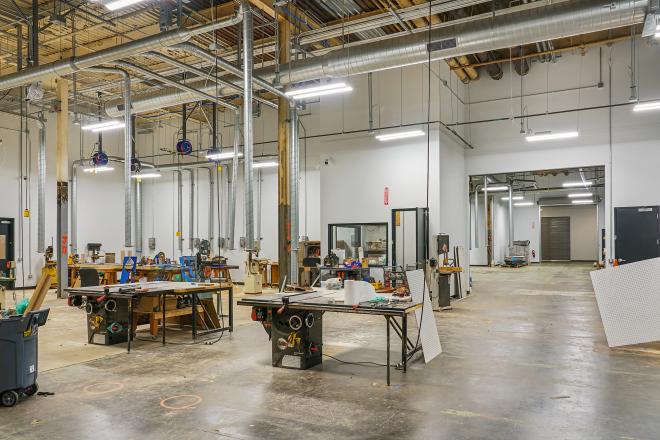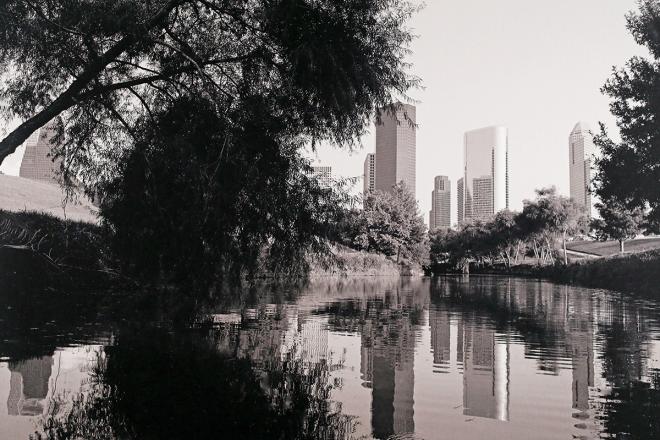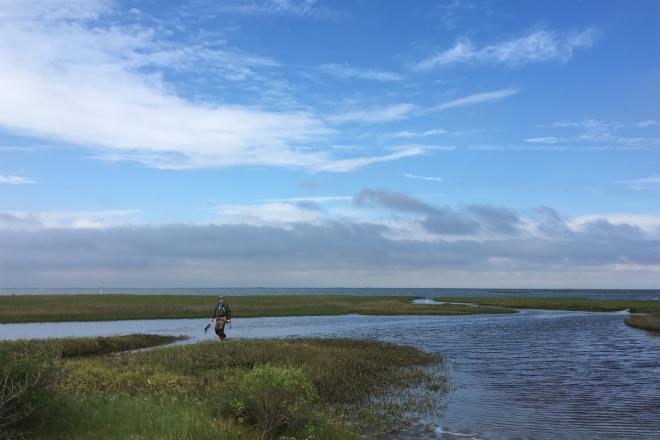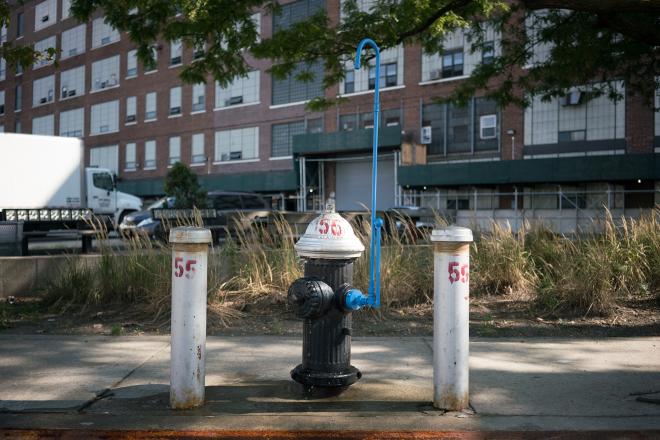
The sidewalks of Peterson Park, Chicago, Illinois.
An excerpt from the following article by Rich Levy appears in Cite 92, a special issue on education available now at Brazos Bookstore, CAMH, MFAH, Issues, River Oaks Bookstore, and other stores.
Walt Whitman wrote, in his odd, garrulous essay "Democratic Vistas:"
I say the question of Nature, largely consider’d, involves the questions of the esthetic, the emotional, and the religious—and involves happiness. A fitly born and bred race, growing up in right condition of out-door as much as in-door harmony, activity and development, would probably, from and in those conditions, find it enough merely to live—and would, in their relations to the sky, air, water, trees, &c., and to the countless common shows, and in fact of life itself, discover and achieve happiness—with Being suffused night and day by wholesome extasy, surpassing all the pleasures that wealth, amusement, and even gratified intellect, erudition, or the sense of art, can give.
In other words, get out of the house! Go for a walk. God bless Walt Whitman.
>>>>>>>>>>>>>>>>>
I was on a bike ride years ago when I saw one near the rural edge of Des Moines. After the neighborhoods vanished, among the creeks and woods, fields of corn and soybean, running next to the newly paved street I rode on, within the city limits and heading west, there it was: a sidewalk, also new, following me for miles, announcing to the world that access for schoolchildren, the aged, any washed or unwashed wanderer was available, and that connection was desired.
It didn’t matter that the sidewalk had no particular place to go. Block after semi-rural block (with cut curbs, even), this sidewalk fulfilled the civic obligation to provide pedestrians with a place to gather and travel next to the road. The city endeared itself to me then, in its fidelity to democracy. This, it seemed, was representative of Whitman’s vision of a transcendent America, one in which rural and urban, vehicular and pedestrian, are equally valued. It gave me hope.
>>>>>>>>>>>>>>
When I think of the sidewalks of my youth, growing up on the north side of Chicago, I think of how regular they were. On the side streets of Rogers Park, West Rogers Park, Peterson Park, they were invariably of the same width, in the same relation to the curb, always separating front yards from parkway, block after block, regardless of neighborhood, whether in front of single family dwellings or apartment buildings. Thanks to Chicago’s reclaimed-swamp flatness (something it shares with Houston) and the grid of its streets, the lines of our sidewalks converged to a vanishing point. A safe distance from the city traffic, the sidewalk validated us—we felt every bit as entitled to be there as the ubiquitous green and white CTA buses.
I learned to walk on a sidewalk, and can still see my sister toddling down the street in front of our three-flat. We rode our bikes on the sidewalk, skinned our knees on them, played hopscotch and Chinese jump rope and freeze tag on them, red rover, Simon says, duck-duck-goose. Crossing the street at the end of the block was a rite of passage. Our neighbor, Mrs. Goldstein, would grumble and stagger by us, hobbling to the grocery store, bakery, or drug store on Devon Avenue two blocks away, pulling her folding two-wheeled shopping cart.
Sidewalks in Chicago, at least on the far north side, didn’t vary much. It is unimaginable for a Chicago sidewalk to deviate from its course because of a tree—not that Chicago doesn’t have grand trees, but because the sidewalk comes first. People plant grass and trees in the parkway not because they own this strip of land, but because they want their street to be handsome.
>>>>>>>>>>>>>>>>

Pedestrians on Westheimer at twilight. Photograph by Claudia Casbarian.
As I watch a disheveled man slowly cross Westheimer and Montrose against the light, glaring at the angry motorists whose rights have been momentarily abridged, I marvel at the flux of power relationships at street level.
I can’t imagine James Dean and his buddies walking on the sidewalk in Rebel Without a Cause. The street is the place where the powerless—teenagers, homeless people, the elderly—can assert themselves for a moment and challenge the established order, which gives preference to motorized vehicles. The teens can laugh and block traffic, dare the cars to defy them. In urban popular culture, it’s the office worker, the tired shop girl, the day laborer who keep quietly to the sidewalk.
David Theis, in his Cite 89 piece “Westheimer on Foot,” asks the rhetorical question, “How could Westheimer’s public realm be made worthy of its culture?” A kind of parallel question could be asked not only of lower Westheimer, with its street people and fine upscale restaurants, but of Houston in general: how can Houston be made worthy of its people? The Houston Coalition for Complete Streets is in the early phases of trying to answer that question. Sidewalks and streets that have a culture friendly to pedestrians and bicyclists are part of the answer. Mayor Parker has recently announced plans that would make some tentative steps towards the city taking responsibility for sidewalk repairs.
In Houston, we are for the most part socio-economically stratified on the street—the lower classes walking or taking buses, the middle and upper classes in vehicles, one person each. There is neither safety for pedestrians—sidewalks throughout the city are mostly poor or nonexistent—nor is there a concerted effort to make the street-level built environment pleasant and appealing.
This is unfortunate, because with usually seven months when the heat is not oppressive Houston could be a fine walking city. But with the poor condition or lack of sidewalks and the predominance of roads, Houstonians tend not to walk from place to place, and therefore miss the birdsongs, dappled light, breezes, and occasional inadvertent contact with others. We are isolated by the automobile, cut off from our surroundings, which deprives us of the calls of doves and grackles, the smell of baking, the chance to pet a dog. We might even chat with a stranger.

An AARP walk audit conducted in Houston.
>>>>>>>>>>>>>
When my parents moved from New York to Chicago in 1956, they bounced around a bit on the north side, eventually ending up for several years on Richmond Street in West Rogers Park.
Every street had beautiful shaded sidewalks that were shoveled in the winter, raked in the fall, and well maintained. Our building was a block and a half north of Devon Avenue, a major east-west thoroughfare that started at Lake Michigan. California Avenue, another major street that traverses the length of the city north to south, is parallel to Richmond, a few blocks east.
Almost everything we needed was within walking distance. On Devon: Green Elementary, our public school; the High-Low Grocery, where my mother once won a drawing for a Thanksgiving turkey; Levenson’s Bakery, where everyone bought bread and rolls; two hot dog shops, The Bow-Wow and the Hot Dog Ranch; Minky’s Bike Shop, source of “novelties”—rubber throw-up, hand-shake buzzers, whoopee cushions, squirting boutonnières; Barton’s Candy Store, for every kind of black licorice; and Lee’s Pharmacy, where Mom went for medicine and I spent my allowance on comic books, Slim Jims, and gum. On California: the Northtown Branch of the Chicago Public Library, with its Saturday morning story hour; our doctor’s office; the fire station; our synagogue, Ner Tamid. Chippewa Park and its teeter-totters, swings, slides, monkey bars, and ice cold public sprinkler—about 10 feet high and a joy on summer days—was four blocks away.
At the corner of Richmond and Devon, almost within sight of our front door, was Kumoon’s, a Cantonese-style restaurant owned by Allen Hom’s family. One of my classmates at Green School, Allen and his parents and sister lived in the apartment upstairs, of which I was terribly jealous. We ate at Kumoon’s every Friday in summer, in a red booth and air-conditioned splendor, to give Mom a break in the kitchen.
The neighborhood was designed around the assumption that most residents did not have a car. But the future was less than a mile away: one of Chicago’s first shopping centers, Lincoln Village, which opened in 1951 and had in its prime about 30 locally owned stores—including Wieboldt’s Department Store and the Bagel & Tray Delicatessen—and 1,300 parking spots. Of course we shopped there, just eight blocks from our apartment; and because there were no sidewalks leading to it from Devon, which puzzled me as a child, we drove to it.
>>>>>>>>>>>>>
In the 1950s, the neighborhood school was the key to neighborhood planning. In 1965, my parents bought their first house, a tiny two-story three-bedroom mock-Georgian in Peterson Park, west of West Rogers Park—we moved about a mile from the apartment on Richmond. To the north of Devon was Lincolnwood, the leading edge of the vast network of northern suburbs.
In the center of Peterson Park sat Hannah Greenebaum Solomon Elementary School, kindergarten through 8th grade. This physical arrangement meant that no child had to cross a major street to get to school. Again the Chicago street grid facilitates this—but equally important was the city’s devotion to sidewalks.
Our school had a safety-patrol crossing guard along the main routes—6th, 7th, and 8th grade boys and girls helping the younger children get safely to and from school, morning and afternoon. Carpools were unnecessary and unheard of in Peterson Park. Children ate brown-bag lunches in the gym, or joined a parent (usually one’s mother) at home or work for lunch.
I was a member of the safety patrol—a privilege reserved for those who were both responsible enough both to do what they were told and not lose the belt—orange, reflective, plastic-coated, buckling over the shoulder, across the chess, and around the waist. We felt important in our safety-patrol belts, most of which were new and gleaming.
One morning the captain of the patrol, a lieutenant, and I (also a lieutenant) had finished making the rounds of the routes by bike, and we were passing the time before the final bell, when we verified the last of the patrol girls and boy were at school and then we raced there ourselves. The captain had a handful of paper clips, which he broke in half, firing pieces with a rubber band at passing cars. We were all doing it and laughing—until one hit the driver of a diaper-service step-van in the face, and he slammed on the brakes, grabbed the three of us, and dragged us to the principal’s office.
Terrified, I confessed, the others prevaricated, they were dismissed from the patrol, and I was made captain. To this day, I still don’t quite understand how it all happened—but order was maintained.
>>>>>>>>>>>>>
All of the Jewish families in the neighborhood—I think we constituted as much as 90 percent of it in the late 1960s—sent their children to Hebrew school at the neighborhood synagogue starting in fourth grade, so that we could prepare for our bar or bat mitzvah when we turned 13, in eighth grade. That meant that at 3 pm, three days a week, there was a significant stream of children walking from school to temple on a single pre-determined route.
One day a new sidewalk was poured three houses from the synagogue parking lot where we played softball. We couldn’t resist—three of us wrote our initials in the wet smooth concrete. Immediately the man of the house, who was lurking just inside the front door, sprang upon us and hustled us to the office of Mr. Lang, a Holocaust survivor who directed the Hebrew school. Mr. Lang’s entire family was killed by hanging, and as a result he never buttoned his shirt at the neck or tightened his tie. Mr. Lang spoke softly to us, telling us how disappointed he was, his tie loose and collar open. We thought he was about to cry. We cried instead and apologized.
>>>>>>>>>>>>>
This spring I was driving north on the Hardy Toll Road early one morning, when I spotted two girls walking to school along the feeder road. It was a cool crisp morning, and they were wearing jackets and full backpacks—one about 14, the other 11 or 12. Sisters, I imagined. It was unusual to see any pedestrians on the feeder road, which had no sidewalks and along which people drove at ridiculous speeds. The girls slogged across the muddy front yards of the small homes, churches, car repair shops, on their way to Patrick Henry Middle School, at the intersection of the Hardy Toll Road and Little York Road. When I saw the girls, they had about a half mile to go.
If there was a polar opposite to my bosky and peaceful Peterson Park experience, this was it. The girls paid very careful attention to where they stepped, avoiding puddles and the edge of the road, no schoolmates in sight.
Of course, the school preceded the toll road—but not the railroad tracks around which the highway was built. It’s hard to imagine a less pedestrian-friendly school location. Obviously the neighborhood school had already become a thing of the past when this school was sited.
>>>>>>>>>>>>>>
Sidewalks are tropes of order, but sometimes it doesn’t work that way. Harper High School, located in the neighborhood of West Englewood, is a Chicago public school at which 29 current and former students were killed in 2011-2012 as a result of gang violence. Harper students, as a result of pervasive gang activity in the area, have developed certain habits. For example, they walk to school in the street, not on the sidewalk. Sidewalks afford too many hiding places—behind trees and hedges, in doorways—where armed gang members can hide. The students feel safer in the street, in plain sight of everyone—drivers, residents, police. The very thing that we treasure about sidewalks—that they are places of encounter and intimacy—is what can make them deadly, when chaos rules.
The era of the neighborhood school officially ended in Chicago this spring. In March, the Chicago Public Schools (CPS) announced the closing of 54 schools across the city. This consolidation is taking place in a shrinking urban school district in which 87 percent of the 400,000 students enrolled are classified as low-income. Most CPS students must walk or take a bus to school, and school closings create safety hazards by putting schools farther from home. My mother won a battle against the CPS in 1961, when they tried to zone kids on our block to a school twice as far away as nearby Green School. School placement in Chicago is no longer a means of neighborhood cohesion—it’s a source of anxiety.
>>>>>>>>>>>>>>
I find few things as beautiful in Houston as the sidewalks on the Rice University campus. There are places, especially in the center of campus, where long straight paths intersect other paths at 90 degree angles, or 45 degree angles, beneath a thick canopy of live oaks, bracketing swaths of manicured lawn. This is not a natural scene, but a landscape maintained for the benefit of the Rice community. It is also a rarified and very exclusive place.
Still, I am touched by it each time I ride my bike across campus. I know the grounds are expensive to maintain, but I love the order and connectivity these paths imply. They also represent for me a kind of community cohesion I wish could be replicated throughout the city.
Where are the sidewalks in our neighborhoods, the ones that offer safety and may alter the way we live and arrange ourselves? I hope we all support the Houston Coalition for Complete Streets, no matter where in Houston we are situated—especially in areas where six- and eight-lane thoroughfares predominate, and pedestrians, bicyclists, the elderly, and children are afterthoughts.
The long-term future of Houston may be determined in part by how we reconcile the opposition between efficient transport and quality of life. San Francisco recently dismantled a section of freeway that cut through a part of the city. The result: wider sidewalks, new parks, safer streets, more sunlight, trees—in other words, a better place to live.
>>>>>>>>>>>>>>>>
The struggle for pedestrian space in Houston makes me think of the closing lines of Whitman’s great poem Song of Myself:
Failing to fetch me at first keep encouraged,
Missing me one place search another,
I stop somewhere waiting for you.
On a sidewalk, I hope.










